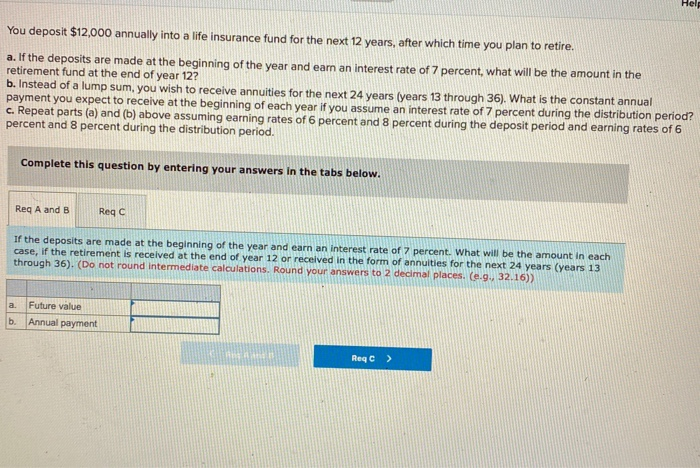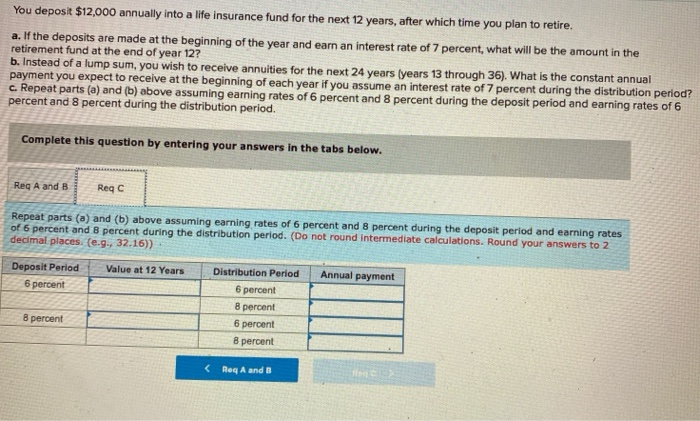Help You deposit $12,000 annually into a life insurance fund for the next 12 years, after which time you plan to retire. a. If the deposits are made at the beginning of the year and earn an interest rate of 7 percent, what will be the amount in the retirement fund at the end of year 12? b. Instead of a lump sum, you wish to receive annuities for the next 24 years (years 13 through 36). What is the constant annual payment you expect to receive at the beginning of each year if you assume an interest rate of 7 percent during the distribution period? c. Repeat parts (a) and (b) above assuming earning rates of 6 percent and 8 percent during the deposit period and earning rates of 6 percent and 8 percent during the distribution period. Complete this question by entering your answers in the tabs below. Req A and B Regc If the deposits are made at the beginning of the year and earn an interest rate of 7 percent. What will be the amount in each case, if the retirement is received at the end of year 12 or received in the form of annuities for the next 24 years (years 13 through 36). (Do not round Intermediate calculations. Round your answers to 2 decimal places. (e.g. 32.16)) a. Future value Annual payment b. linn Reqc > You deposit $12,000 annually into a life insurance fund for the next 12 years, after which time you plan to retire. a. If the deposits are made at the beginning of the year and earn an interest rate of 7 percent, what will be the amount in the retirement fund at the end of year 12? b. Instead of a lump sum, you wish to receive annuities for the next 24 years (years 13 through 36). What is the constant annual payment you expect to receive at the beginning of each year if you assume an interest rate of 7 percent during the distribution period? c. Repeat parts (a) and (b) above assuming earning rates of 6 percent and 8 percent during the deposit period and earning rates of 6 percent and 8 percent during the distribution period. Complete this question by entering your answers in the tabs below. Reg A and B Reqc Repeat parts (a) and (b) above assuming earning rates of 6 percent and 8 percent during the deposit period and earning rates of 6 percent and 8 percent during the distribution period. (Do not round intermediate calculations. Round your answers to 2 decimal places. (e.g., 32.16)) Value at 12 Years Deposit Period 6 percent Annual payment Distribution Period 6 percent 8 percent 6 percent 8 percent 8 percent You deposit $12,000 annually into a life insurance fund for the next 12 years, after which time you plan to retire. a. If the deposits are made at the beginning of the year and earn an interest rate of 7 percent, what will be the amount in the retirement fund at the end of year 12? b. Instead of a lump sum, you wish to receive annuities for the next 24 years (years 13 through 36). What is the constant annual payment you expect to receive at the beginning of each year if you assume an interest rate of 7 percent during the distribution period? c. Repeat parts (a) and (b) above assuming earning rates of 6 percent and 8 percent during the deposit period and earning rates of 6 percent and 8 percent during the distribution period. Complete this question by entering your answers in the tabs below. Reg A and B Reqc Repeat parts (a) and (b) above assuming earning rates of 6 percent and 8 percent during the deposit period and earning rates of 6 percent and 8 percent during the distribution period. (Do not round intermediate calculations. Round your answers to 2 decimal places. (e.g., 32.16)) Value at 12 Years Deposit Period 6 percent Annual payment Distribution Period 6 percent 8 percent 6 percent 8 percent 8 percent








